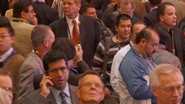Thousands of iPhones simultaneously discover limits of unicast at CES

"A new remote-control device for tuning a radio set from a distance was demonstrated last week in New York by its inventor Walter Faas of Irvington, NJ," reported the March 3, 1929 New York Times in its preview of the upcoming Radio World's Fair. The other thing that was happening at that 1929 trade show was General Electric's experimental TV, which, reportedly, required the hands-on assistance of "several engineers" to be coaxed into operation.
I thought of that 1929 trade show when I read the recent post "10 cool new toys from CES," by CNN's John D. Sutter and Brandon Griggs. Among the exciting things catching their eyes at the recent CES was Valups' Tivit, "a cute, credit-card-sized device, catches live TV signals — like local weather and news — and brings them to smartphones such as the iPhone, Blackberry and Droid … [which] uses an antennae to pick up mobile free digital TV signals from local TV stations and transmits them to phones via WiFi." The big benefit, according to Sutter and Griggs, was: "Upgrade to mobile TV without getting a new phone."
Almost a century later, we know that the remote control was a hit with consumers — that is, for tuning our TV sets. Likewise, I'm sure that coming years will reveal the most important thing at CES 2010 to be something that few industry pundits are thinking about right now.
My choice for the biggest unrecognized CES story is that the next generation of TV, “TV 3.0,” will be over-the-air broadcast, and the reason has nothing to do with anything that was officially being demonstrated at CES. Rather, it was the unintentional demonstration of what happens when tens of thousands of AT&T's iPhone subscribers converge on the same square mile: They couldn't make phone calls.
AT&T was reportedly in denial about it, telling one iPhone user I spoke to that system problems in the northeast were affecting services. These mysterious "system problems" were curiously selective, because they didn't seem to afflict AT&T's non-iPhone customers.
The picture of thousands of frustrated subscribers yelling at their iPhones should give pause to those who insist that broadcast is "so over," as well as the endorsers of a 3G, unicast model for mobile TV. Bandwidth, spectrum, speed — none of these are extendable to the extent that would allow every one of the world's current 3 billion cell phone subscribers to watch the same thing at the same time, never mind making phone calls. However, broadcasting exactly fits the job of mass communication.
"Every once in a while, a kick in the pants is a good thing," is how ION Media Networks CEO Brandon Burgess put it in the TV to Go roundtable. "I think broadcasters have to do a better job of explaining themselves. We are essentially wireless broadband. The current [mobile phone] unicast system is not designed for a situation like this convention — a couple hundred thousand people [in one place]. There's no spectrum that can handle that assignment."
Perhaps that's why someone shared with me a prediction that the 2010 will be known as the inflection point where broadcasters took over CES.
Get the TV Tech Newsletter
The professional video industry's #1 source for news, trends and product and tech information. Sign up below.
